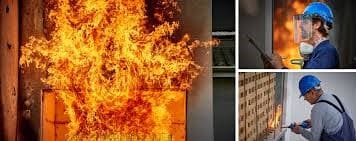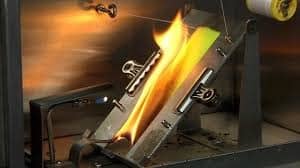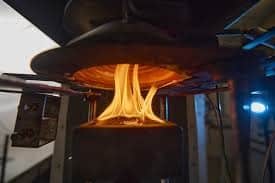Fire and Flame Testing
METS Lab offers a wide range of Flammability and fire testing services suited for various types of materials/components ensure your materials and products. Meet industrial regulations and safety standards as well as your own-is critical, so we arm to meet all of your fire testing needs quickly and efficiently.
At METS Lab, we are an expert in fire testing and flammability testing. We offer world wide support to clients across a range of industries, including transportation, construction, industrial, chemical and more.
What is fire and flammability testing?
At its core, fire and flammability testing is the act of taking a product and testing its resistance to heat, electrical current, open flames and other conditions that might cause a fire. Most importantly, a fire and flammability testing does so in a rigorous, quantifiable manner that creates usable results.
Fire and flammability test generally include fire reaction, fire resistance, fire spread and also depending on the test program and the industry standards, fire and flammability test may require additional timing and measurements devices-METS Lab can help you ensure a clean and functional product testing environment. Fire tests, or flammability tests, measure how easily materials ignite, how quickly they burn, and how they react when burned. METS Lab use various testing methods, depending on international flammability testing standards and the type of material being tested.
We perform tests on samples in controlled conditions to determine the following:
- Fire resistance – To determine the ability of materials used in the manufacturing of products to withstand fire or provide protection for a period of time.
- Flame spread – To measure the propagation of flames away from the source of ignition, across the surface of the sample and evaluate the potential for flames spreading in the event of a fire.
- Reaction to fire – To evaluate the extent to which a product contributes to fire when exposed to flames.
Types of Products Which Require Fire or Flammability Testing
Regulations governing fire testing methods vary depending on the type of product and the material it’s comprised of, such as:
- Clothing textiles and vinyl plastic film for apparel
- Children’s sleepwear
- Carpets and rugs
- Drapes and drapery linings
- Polymers (plastics) used in electronic products and appliances
- Fabrics and textiles used in furniture and bedding
- Interior and exterior building materials
- Toys
METS Lab is a certified industry leader in testing industries that need fire and flammability testing aerospace, automotive, marine and rail, military and government, construction and engineering, chemical with years of experience, METS Lab is your Go-To fire testing laboratory.
METS lab is one of the leading fire testing labs in UAE. We are accredited to carry out the fire testing you need to get your products certified for your destination market.
International Fire Testing Standards Which METS follows :
- ASTMD635- Standard test method for rate of burning and/or extent and time of burning of plastics in a horizontal position.
- ASTMD1929- Standard test method for determining ignition temperature of plastics.
- ASTMD3801- Standard test method for measuring the comparative burning characteristics of solid plastics in a vertical position.
- ASTME84- Standard test method for surface burning characteristics of building materials.
- ASTME136- Standard test method for assessing combustibility of materials using a vertical tube furnace at 750 °c
- ASTME2652- Standard test method for assessing combustibility of materials using a tube furnace with a cone-shaped airflow stabilizer, at 750°c
- ASTME2768- Standard test method for extended duration surface burning characteristics of building materials (30 min tunnel test)
- BS476-4- Fire tests on building materials and structures- part 4: non-combustibility test for materials.
- BS476-6- Fire tests on building materials and Method of test for fire propagation for products
- IEC60695-11-10- Fire hazard testing – Part 11-10: Test flames – 50 W horizontal and vertical flame test methods.
- IEC60695-2-10- Fire hazard testing: Glowing/Hot-wire Based Test Methods – Glow-wire Apparatus and Common Test Procedure
- IEC60695-2-11- Fire hazard testing – Part 2-11: Glowing/hot-wire based test methods – Glow- wire flammability test method for end products (GWEPT)
- IEC60695-2-13- Fire hazard testing – Part 2-13: Glowing/hot-wire based test methods – Glow- wire ignition temperature (GWIT) test method for materials
- IEC62115- Electric toys – Safety only Clause 2.2 Resistance to fire non-metallic parts
- ISO1182- Reaction to fire tests for products — non-combustibility test
- UL-94- Standard for safety of flammability of plastic materials for parts in devices and appliances testing.
- UL 723- Test for surface burning characteristics of building materials.
ASTM E 84
The ASTM E-84 is a test developed by the American Society of Testing and Materials (ASTM). It assesses the burning behavior of a material. This fire test provides comparative measurements of surface-level flame spread and smoke density.
This fire-test-response standard for the comparative surface burning behavior of building materials is applicable to exposed surfaces such as walls and ceilings. The test is conducted with the specimen in the ceiling position with the surface to be evaluated exposed face down to the ignition source. The material, product, or assembly shall be capable of being mounted in the test position during the test. Thus, the specimen shall either be self-supporting by its own structural quality, held in place by added supports along the test surface, or secured from the back side.
The requirements for the ASTM E-84 test differ based on the material. According to the International Building Code, the test is required for interior wall and ceiling finishes. The National Fire Protection Agency 101® Life Safety Code® also requires testing for interior wall and ceiling finishes.
The ASTM E-84 test is ranked based on the flame spread index (FSI) and the smoke development index (SDI) . The FSI is a measure of the speed that flames progress across a material. FSI accounts for flame initiation and flame travel during the test. The SDI measures smoke intensity during the test interval. SDI is obtained with a light obscuration meter. This measures the optical density of the smoke development. In other words, it gives a measure of how much light can travel through the smoke.
The Critical Role of Fire Testing in Ensuring Safety and Compliance
Fire safety is a paramount concern across various industries, from construction and manufacturing to transportation and consumer goods. Ensuring that materials, products, and structures can withstand fire hazards is not just a regulatory requirement but also a moral obligation to protect lives and property. This is where fire testing comes into play. Fire testing labs provide essential services to assess the fire resistance, flammability, and overall safety of materials and products. In this article, we’ll explore the critical role of fire testing and why it is indispensable for ensuring safety and compliance.

Understanding Fire Testing: What It Entails
Fire testing involves subjecting materials, products, or structures to controlled fire conditions to evaluate their performance in the event of a fire. These tests measure various parameters, including the rate of flame spread, heat release, smoke production, and the structural integrity of the material under fire exposure.
METS Lab is a certified laboratory for fire and flammability testing aerospace, automotive, marine and rail, military and government, construction and engineering with years of experience.
METS lab utilizes a range of testing methods depending on the specific requirements of the material or product. Some common fire tests include:
● Flammability Testing:
Measures how easily a material ignites and how quickly flames spread across its surface.

Test Method :
- ASTMD635- Standard test method for rate of burning and/or extent and time of burning of plastics in a horizontal position.
- ASTMD1929- Standard test method for determining ignition temperature of plastics.
- ASTMD3801- Standard test method for measuring the comparative burning characteristics of solid plastics in a vertical position.
- ASTME84- Standard test method for surface burning characteristics of building materials.
- ASTME136- Standard test method for assessing combustibility of materials using a vertical tube furnace at 750 °c
- ASTME2652- Standard test method for assessing combustibility of materials using a tube furnace with a cone-shaped airflow stabilizer, at 750°c
- ASTME2768- Standard test method for extended duration surface burning characteristics of building materials (30 min tunnel test)
- BS476-4- Fire tests on building materials and structures- part 4: non-combustibility test for materials.
- BS476-6- Fire tests on building materials and Method of test for fire propagation for products
- IEC60695-11-10- Fire hazard testing – Part 11-10: Test flames – 50 W horizontal and vertical flame test methods.
- IEC60695-2-10- Fire hazard testing: Glowing/Hot-wire Based Test Methods – Glow-wire Apparatus and Common Test Procedure
- IEC60695-2-11- Fire hazard testing – Part 2-11: Glowing/hot-wire based test methods – Glow- wire flammability test method for end products (GWEPT)
- IEC60695-2-13- Fire hazard testing – Part 2-13: Glowing/hot-wire based test methods – Glow- wire ignition temperature (GWIT) test method for materials
● Fire Resistance Testing:
Evaluates how long a material or structure can withstand fire exposure without losing its load-bearing capacity or integrity.

Test Method:
- ASTME1966-15(2019) Standard Test Method for Fire-Resistive Joint Systems
- ASTME3021/E3021M-15(2019) Standard Guide for Evaluating the Relative Effectiveness of Building Systems to Resist the Passage of Products of Combustion Based on the Aggregation of Leakage Rates
- ASTME3134-20 Standard Specification for Transportation Tunnel Structural Components and Passive Fire Protection Systems
- ASTME2336-20 Standard Test Methods for Fire Resistive Grease Duct Enclosure Systems
- ASTME2074-00e1 Standard Test Method for Fire Tests of Door Assemblies, Including Positive Pressure Testing of Side-Hinged and Pivoted Swinging Door Assemblies (Withdrawn 2007)
- ASTME2010-01 Standard Test Method for Positive Pressure Fire Tests of Window Assemblies (Withdrawn 2007)
- ASTME2816-20a Standard Test Methods for Fire Resistive Metallic HVAC Duct Systems
- ASTME2032-21 Standard Practice for Extension of Data From Fire Resistance Tests Conducted in Accordance with ASTM E 119
- ASTME1529-22 Standard Test Methods for Determining Effects of Large Hydrocarbon Pool Fires on Structural Members and Assemblies
- ASTME2748-23 Standard Guide for Fire-Resistance Experiments
- ASTME2750-23 Standard Guide for Extension of Data from Penetration Firestop System Tests Conducted in Accordance with ASTM E814
- ASTME1725-23 Standard Test Methods for Fire Tests of Fire-Resistive Barrier Systems for Electrical System Components
- ASTME2874-23 Standard Test Method for Determining the Fire-Test Response Characteristics of a Building Spandrel-Panel Assembly Due to External Spread of Fire
- ASTME2307-23b Standard Test Method for Determining Fire Resistance of Perimeter Fire Barriers Using Intermediate-Scale, Multi-story Test Apparatus
- ASTME2837-23a Standard Test Method for Determining the Fire Resistance of Continuity Head-of-Wall Joint Systems Installed Between Rated Wall Assemblies and Nonrated Horizontal Assemblies
- ASTME2226-23a Standard Practice for Application of Hose Stream
- ASTME814-24 Standard Test Method for Fire Tests of Penetration Firestop Systems
- ASTME119-24 Standard Test Methods for Fire Tests of Building Construction and Materials
- ASTME2749-24 Standard Practice for Measuring the Uniformity of Furnace Exposure on Test Specimens
• Test Methods For Fire Safety Engineering
- E1546-21 Standard Guide for Development of Fire-Hazard-Assessment Standards
- E1591-20 Standard Guide for Obtaining Data for Fire Growth Models
- E1472-07 Standard Guide for Documenting Computer Software for Fire Models (Withdrawn 2011)
- E1895-07 Standard Guide for Determining Uses and Limitations of Deterministic Fire Models (Withdrawn 2011)
- E3020-22 Standard Practice for Ignition Sources
- E1776-22 Standard Guide for Development of Fire-Risk-Assessment Standards
- E1355-23 Standard Guide for Evaluating the Predictive Capability of Deterministic Fire Models
• Test Methods For Furnishings and Contents
- E1353-21 Standard Test Methods for Cigarette Ignition Resistance of Components of Upholstered Furniture (Withdrawn 2022)
- E1352-16 Standard Test Method for Cigarette Ignition Resistance of Mock-Up Upholstered Furniture Assemblies (Withdrawn 2022)
- E3082-20 Standard Test Methods for Determining the Effectiveness of Fire-Retardant Treatments for Natural Christmas Trees
- E1822-21 Standard Test Method for Fire Testing of Stacked Chairs
- E2280-21 Standard Guide for Fire Hazard Assessment of the Effect of Upholstered Seating Furniture Within Patient Rooms of Health Care Facilities
- E1537-22 Standard Test Method for Fire Testing of Upholstered Furniture
- E1590-23 Standard Test Method for Fire Testing of Mattresses
- E2187-24 Standard Test Method for Measuring the Ignition Strength of Cigarettes
• Smoke Toxicity Testing:
Assesses the type and concentration of toxic gases released during combustion, which is crucial for assessing the safety of building materials and furnishings.

• Test Methods For Smoke and Combustion Products
- E800-20 Standard Guide for Measurement of Gases Present or Generated During Fires
- E2405-05 Standard Test Method for Determination of Fire and Thermal Parameters of Materials Using an Intermediate Scale Test with Vertically Oriented Specimen (Withdrawn 2011)
- E1995-21 Standard Test Method for Measurement of Smoke Obscuration Using a Conical Radiant Source in a Single Closed Chamber, With the Test Specimen Oriented Horizontally
- ASTME662-21ae1 Standard Test Method for Specific Optical Density of Smoke Generated by Solid Materials
- ASTME906/E906M-21 Standard Test Method for Heat and Visible Smoke Release Rates for Materials and Products Using a Thermopile Method
- ASTME2102-21 Standard Test Method for Measurement of Mass Loss and Ignitability for Screening Purposes Using a Conical Radiant Heater
- ASTME1474-22 Standard Test Method for Determining the Heat Release Rate of Upholstered Furniture and Mattress Components or Composites Using a Bench Scale Oxygen Consumption Calorimeter
- ASTME1740-22 Standard Test Method for Determining the Heat Release Rate and Other Fire-Test-Response Characteristics of Wall Covering or Ceiling Covering Composites Using a Cone Calorimeter
- ASTME2257-22 Standard Test Method for Room Fire Test of Wall and Ceiling Materials and Assemblies
- ASTME3048-22a Standard Test Method for Determination of Time to Burn-Through Using the Intermediate Scale Calorimeter (ICAL) Radiant Panel
- ASTME1623-22a Standard Test Method for Determination of Fire and Thermal Parameters of Materials, Products, and Systems Using an Intermediate Scale Calorimeter (ICAL)
- ASTME603-23 Standard Guide for Room Fire Experiments
- ASTME1354-23 Standard Test Method for Heat and Visible Smoke Release Rates for Materials and Products Using an Oxygen Consumption Calorimeter
- ASTME3367-23 Standard Test Method for Determining the Combustion Behavior of Layered Assemblies using a Cone Calorimeter
- ASTME2067-23 Standard Practice for Full-Scale Oxygen Consumption Calorimetry Fire Tests
- ASTME1678-24 Standard Test Method for Measuring Smoke Toxicity for Use in Fire Hazard Analysis
Other Test Methods of Fire Testing:
- ISO 7202 : Fire protection — Fire extinguishing media — Powder-Bulk density
- ISO 7202 : Fire protection — Fire extinguishing media — Powder-Size retained on 40µm
- ISO 7202 : Fire protection — Fire extinguishing media — Powder-Size retained on 63µm
- ISO 7202 : Fire protection — Fire extinguishing media — Powder-Size retained on 125µm
- ISO 7202 : Fire protection — Fire extinguishing media — Powder-Fire test performance
- ISO 7202 : Fire protection — Fire extinguishing media — Powder-Moisture content
- SASO 124: Portable Fire Extinguishers Part 3: Foam Fire Extinguishers Wall Thickness
- SASO 124: Portable Fire Extinguishers Part 3: Foam Fire Extinguishers-Leakage Test
- SASO 124: Portable Fire Extinguishers Part 3: Foam Fire Extinguishers Bursting Strength
- SASO 125: Fire protection — Fire extinguishing media — Powder Clause 13.1 Bulk density
- SASO 125: Fire protection — Fire extinguishing media — Powder-Fire test performance
- SASO 125: Fire protection — Fire extinguishing media — Powder-Size retained on 40µm
- SASO 125: Fire protection — Fire extinguishing media — Powder-Size retained on 63µm
- SASO 125: Fire protection — Fire extinguishing media — Powder-Size retained on 125µm
- SASO 125: Fire protection — Fire extinguishing media — Powder-Moisture content
- BS 476-6 : Fire tests on building materials and structures. Method of test for fire propagation for products
- ISO 1182 : Reaction to fire tests for products — Non-combustibility test
The Importance of Fire Testing in Building Materials
In the construction industry, fire testing is particularly critical. Building materials, such as insulation, drywall, flooring, and roofing, must meet strict fire safety standards to be used in construction projects. Fire testing ensures that these materials will not contribute to the rapid spread of fire, giving occupants more time to evacuate and reducing the risk of catastrophic damage.
For example, fire-resistant drywall is designed to prevent the spread of fire between rooms in a building. Through rigorous fire resistance testing, manufacturers can certify that their drywall products meet the necessary standards, providing builders and homeowners with the confidence that the material will perform as expected in an emergency.
Fire Testing in Consumer Products
Beyond construction, fire testing is also essential for consumer products, particularly those that are prone to overheating or are made from combustible materials. This includes items such as electrical appliances, furniture, textiles, and children’s toys. Fire testing ensures that these products do not pose a fire hazard to consumers.
For instance, upholstered furniture must undergo flammability testing to ensure that it doesn’t easily catch fire from common sources like cigarettes or candles. By adhering to fire safety standards, manufacturers can reduce the risk of fires in homes and public spaces, protecting consumers from potential harm.
In METS lab, we test thousands of products annually to characterize their resistance and reaction to fire. Our dedicated team is ready to provide a range of services to support your fire safety testing needs, to confirm performance and compliance.
Conclusion
Fire testing is an essential process that plays a critical role in ensuring the safety and compliance of materials, products, and structures. By rigorously evaluating how these items perform under fire conditions, fire testing labs help prevent disasters, protect lives, and ensure that industry standards are met. Whether in construction, manufacturing, or consumer goods, investing in thorough fire testing is not just about meeting regulations—it’s about safeguarding the well-being of people and communities. As industries continue to innovate, the role of fire testing will remain indispensable in creating safer environments for everyone.


